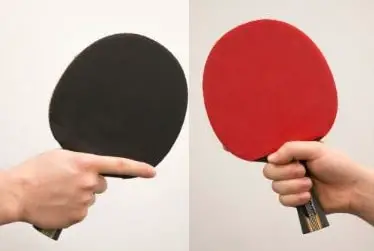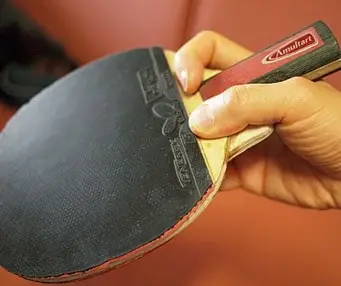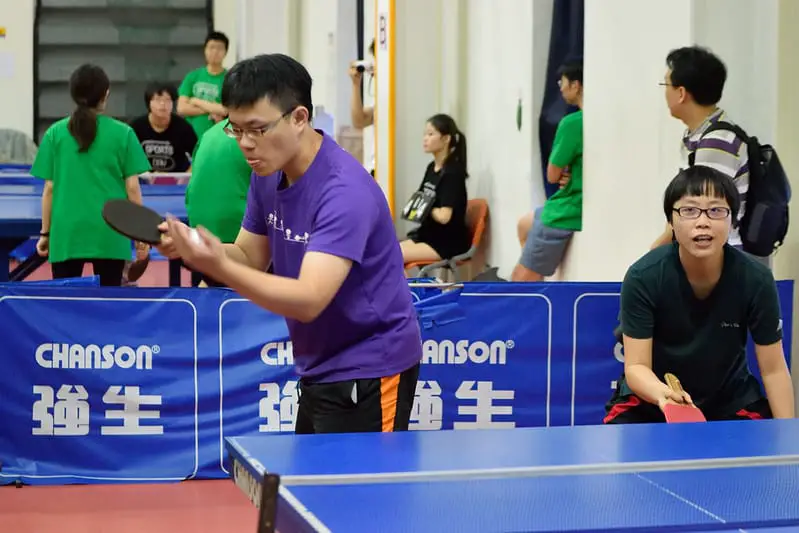One of the first things to learn in table tennis would be the different types of serves you can use to start off along with the various serving grips in table tennis. In this exhaustive guide below, we look at these grips and give you tips and tricks on how to better your table tennis serve.
Before you start off with understanding what are the best methods of serving, it would make sense to read through our guide on the various table tennis serving rules in singles and doubles here.
Once you are done reading the aforementioned article or you already have enough knowledge about all the rules around table tennis serves, you can continue on with this.
Table of Content
Serving Grips
It is tough to play any sport without learning the proper usage of its equipment, right? No different with table tennis either and the best way to improve one’s serve in this sport is to learn to handle a table tennis racket correctly.
What makes things interesting – and challenging – is there are several ways to hold a table tennis racket, each of which add either speed or control or flexibility or a combination of two of these three to your serve.
Here’s a look at the different table tennis grips.
The Shakehand Grip
The most common of all table tennis grips is Shakehand, and as the name suggests, it resembles the posture of the hand when you shake hands with someone.
Here’s how you can use the Shakehand grip.
Grab the paddle’s handle between the space of your thumb and the index finger while curling the last three fingers over the handle. See the image below.

There are two different types of a Shakehand grip, with the difference between them being where the thumb is placed.
Deep Handshake Grip
The thumb rests on the rubber part of the paddle which allows for a firmer hold of the paddle, in turn providing a more accurate shot which is perfect for attacking play which sometimes leads to lack of precision. Furthermore, it allows for flexibility to switch between forehand and backhand strokes.
However this might leave room for indecision to switch between forehand and backhand during a match (known as cross-over point), thus a player needs to be decisive quickly to use this grip to its full advantage.
Shallow Handshake Grip
For this grip, the thumb is placed on the blade of the paddle (the edge or rim of the paddle head). This provides greater flexibility in the wrist thus allowing more spin to the ball while serving.
The crossover point is again a disadvantage for this grip.
Also Read:
Penhold Grip
Similar to holding a pen, this grip requires the thumb and pointer-finger to be curled around the handle’s neck in an “O” shape, touching the rubber part of the paddle while the remaining three fingers are kept straight on the opposite side of the paddle. See image below for demonstration.

There are three different types of Penhold grips.
Chinese Penhold
The paddle is held with the fingers in the same position as show above except, the paddle is held with the head facing downwards instead of up and the last three fingers are slightly curved.
This posture of hand allows more flexibility than any of the Handshake grips thus allowing more spin on the ball which is always an advantage when you attack, especially when you are serving.
The main disadvantage of the handshake grip i.e. the crossover point is solved by the Chinese penhold grip as it allows for better mobility to switch between forehand and backhand positions. This pose is best used by players that stay closer to the table.
The main disadvantage of the Chinese Penhold grip is the lack of ease in performing Backhand Topspin (which will be explained in this article later).
Japanese/Korean Penhold
This grip is again done the same way as shown, with the only difference being the last three fingers’ position, which is to be kept completely straight and not curved.
This allows for more powerful forehand strokes. And furthermore, you need not be very close to the table to use this grip; you can be away from the table to make shots as well.
The main disadvantage of this grip is that it does not allow mobility in the blade movement thus becoming harder for beginner players to master.
Reverse Backhand Grip
This grip is held the same way as the other penhold grips but the difference lies in the wrist posture which is kept constant, meaning that only a backhand stroke would be used thus rectifying the Chinese Penhold’s disadvantage.
Furthermore, it allows for better flexibility to switch between the Chinese Penhold and Reverse Backhand grips hence increasing adaptability.
However, switching between them is difficult and thus beginner players might not find it comfortable also causing the problem of cross-over point.
Moreover, hitting the ball across the net line may become slightly difficult as well, thus a lot of practice is needed for this grip to be mastered.
Check out this video demonstrating a Reverse Backhand Grip.
Types of Serves
Here is the important part that will give you the advantage in getting better at your game than your opponents.
Serving gives players the upper hand given the control you have over the ball without your opponent influencing it at all. If you can handle your paddle correctly while serving the ball’s height, speed, direction and spin can all be dictated the way you want and in your favour.
Before we dive into the different types of serves you can use, there is some terminology that needs to be understood:
Forehand Grip
While keeping a handshake grip on the paddle, if you attack with the palm side of your hand towards the ball, it would be known as the forehand stroke/grip.
Backhand Grip
To hit the ball with the backside of your hand facing the ball is known as the backhand stroke/grip. The trick is to keep your thumb on the rubber part of the paddle while the rest of your ringers curve around the handle.
The thumb will provide the power to hit the ball, much like the Deep Handshake grip.
Now that that’s out of the way, here are some basic and advance serves that you can use.
Also Read:
Basic Serving Techniques
These are serves most commonly taught beginner table tennis players as they are easiest to use.
Topspin Serve
This serve can be performed using both, the forehand and backhand gripping techniques. The point to note while going ahead with the Topspin Serve in table tennis is to hit the ball from the top and graze the ball with the racket in an upward motion while striking it forward.
The opponent will have to repel both the spin and speed of the ball which will put you in a favorable position, assuming your opponent is of a beginner level as well.
Topspin allows the ball to stay low after it lands on the table which is another advantage if the opponent isn’t ready for it.
Steps
- Assuming you are right handed, you should stand with your right foot forward while bending your knees.
- Keep the paddle in the right hand while the ball sits on the palm of your left.
- While keeping the ball at about the level of your chest, toss the ball up in the air at least 6 inches in a vertical manner.
- Keep the paddle at an angle of less than 90 degrees towards the net and when the ball comes back down at chest level or lower, strike the ball from over the top of it, grazing it with the paddle and slightly pushing it forward to accelerate the speed.
Pro Tip
To create proper spin to your ball, it is important to brush the ball over the top with the racket first and then use your wrist to accelerate the amount of spin the ball gets.
Furthermore, try to put strength in striking the ball with your legs, waist, arm and wrist altogether to create the best quality of topspin.
Watch this video on Topspin serves to give you a better idea.
Backspin Serve
This is also known as “Under Spin” or “Bottom Spin” by some but more widely as Backspin as this technique allows the ball to come backwards to you, which thus causes difficulty for your opponent to give a good quality reply to your serve.
Again, a backspin serve can be achieved with both forehand and backhand gripping techniques.
A much too strong backspin would make the ball stay only on your side of the court, which is clearly not ideal considering the ball should touch both sides of the court in Table Tennis.
Practice this technique to figure out the “right amount” of brushing and flicking motion that is needed.
Steps
- This serve requires you to hold your racket horizontally to the ground (similar to as you would hold your palm flat during service to fling the ball up).
- Stand outside the left sideline of the table while keeping your left foot forward in front slightly.
- Toss the ball upwards vertically 6 inches, rotate your body to transfer your weight on your right foot now and strike the ball with the paddle.
- The paddle edge that is further from you should graze the ball from underneath to create a backspin.
- Be sure to use your wrist and create a snapping motion with it while contacting the ball.
Pro Tip
Try to create a strong backspin so that the ball hits the opponent’s side of the court twice so that it becomes harder for them to strike back powerfully.
For a demonstration of a Backspin Serve here is a helpful video
Sidespin Serve
Also known as the “Pendulum Serve”, the Sidespin serve is one used to serve the ball to the opposite side of yours for your opponent which will cause them to keep moving to the opposite ends of their court just to strike the ball back.
Sidespin has many variations as it can be combined with other serves such as “Side Topspin” and “Side Underspin” both of which can be achieved with either forehand or backhand gripping techniques.
Furthermore, you can serve a Long or Short sidespin depending on what your strategy is in winning your game against the opponent.
Ma Long who has been one of the world’s best table tennis players, is known to use these sidespin serves as a deception method frequently during his matches.
Steps
- Stand with a low stance while keeping your wrist loose and arm relaxed. You should stand sideways from the table to allow for the ball to be struck with more ease as your objective is to strike it to one side of the opponent.
- Hold the paddle at a vertical angle with the head facing downwards.
- Toss the ball 6 inches upwards as vertically as you can with just the palm of your hand.
- When the ball reaches your chest level, strike it with the paddle moving from your left to right side across your chest. The ball should be contacted from its side to create a sidespin.
For a demonstration here’s a YouTube video on Sidespin.
Pro Tip
For this serve, keeping the body movement to a minimum is preferred for a better quality serve. Brushing the ball while keeping the wrist loose to let it “whip” will create a finer spin.
There are variations within this serve that contain slight differences which consist of the following:
Side Backspin
Tilt the paddle slightly from a downwards vertical position so that the paddle contacts the ball on its side but slightly touches under the ball as well.
Side Topspin
Tilt the paddle the same as for side-backspin and brush the ball upwards from the side when it contacts the ball.
Long Serves
This is perfect for using to attack opponents even for beginners, the long serve allows the ball to go fast, leap low over the net and end up very near the opponent’s baseline thus making it harder for the opponent to repel the attack.
Furthermore, Long serve is known to be a little deceptive as it looks the same as a normal Sidespin serve until the point of contact between paddle and ball.
Long serves can be complimented with topspin serves, backspin serves and many others but with itself alone, this serve does not require any spin.
Steps
- Keep a low stance with legs spread apart and back slightly hunched forward.
- Hold the paddle with a forehand grip and tilt it so that it is almost horizontal.
- Toss the ball up 6 inches from the chest level.
- When the ball comes back down to your chest level or lower, strike the ball with the top part of the paddle head. On your side of the court, aim for the ball to hit the first 6-7 inches before leaping over the net.
- The striking motion should be with your whole body’s power slightly moving forward to put force on the ball.
The more force you put with your whole body, the faster the ball will go, thus creating a serve known as “Long Fast Serve” which is one that Paul Drinkhall, a six-time British Table Tennis Championship player is famous to use.
Advanced Serving Techniques
Once you have mastered the art of the basic serves and have become comfortable with them, it is time to move on to the expert style serving techniques and become a pro-player!
Punch Serve
This serve is also known as the “Jab Serve”. It imparts heavy spin upon the ball thus making this serve a quite powerful one. Jab serves can be combined with other types of serves such as Topspin Serves, Sidespin Serves etc.
Ma Long who is currently ranked to be the world’s 3rd best Table Tennis player is known to use a combination of Jab Serves a lot as this is also a great method for deception, with the serves being combined with a variety of other serves.
Steps
- Assuming you are right-handed, stand at the left corner of the table with your left leg forward. You should be hunched forward with a low stance.
- The paddle should be held horizontally like a plate.
- Toss the ball upwards about 6 inches, when the ball comes back down to the level of your chest; strike it from underneath the ball with the top part of the paddle head.
- When striking the ball, the waist is rotated slightly and the arm is swung forward with a small wrist action to bring some spin to the ball.
Pro Tip
The arm motion should resemble a punch as the ball is being hit heavily from underneath in a forward motion. Try to put as much power from your arm and body while striking the ball.
Here is a video link for a demonstration for a Punch/Jab Serve
Kicker Serve
Like most table tennis serves, this is yet another serve that deceives the opponent as they expect a simple topspin or backspin until the point of contact between the ball and the paddle, leaving the ball to fly high and cause the opponent to have to defend themselves from away from the table.
Steps
- Assuming you are right-handed; put your left foot back and have your torso face away from the table.
- Keep the paddle in a forehand grip with the paddle head facing upwards.
- When the ball comes back down to chest level from being tossed up to 6 inches, shift your weight to your right foot.
- Make sure the ball grazes the top part of the paddle head and swiftly move the paddle so that the ball slides to the side of the paddle and flick it hard.
- At this point your paddle head should face your right side instead of upwards (assuming you are right handed, if not, it should face your left side).
Here is a video link for a demonstration of a Kicker Serve
Ghost Serve
This serve is tricky for players to master as it contains a lot of Underspin for the ball, but nonetheless, is very effective. This serve requires a short motion of the arm and wrist rather than a full arm being used to hit the ball.
Ma Lin, an Olympic winner at Table Tennis is known to have one of the best Ghost Serves and he most commonly uses the pen hold grip for this technique.
Steps
- Use a Penhold gripping technique for this serve to increase the flexibility in your wrist.
- Keep your playing hand’s elbow close to your body.
- If you are right-handed, the paddle should be kept with its top head facing your right hand-side.
- After tossing the ball up 6 inches, strike the ball with a short flick of the wrist. The front part of the paddle should contact the ball, hitting it from underneath thus creating a backspin.
Final Words on Table Tennis Serves
This is understandably a lot of information around just table tennis serves and we don’t expect you to change things around overnight.
That been said, you can look to push to find your most comfortable style and practice hard over weeks and months to get it become your muscle memory.
Because a good serve goes a long way in table tennis, but more importantly a bad serve can make things very difficult for you – so get those table tennis bats out and get serving.


